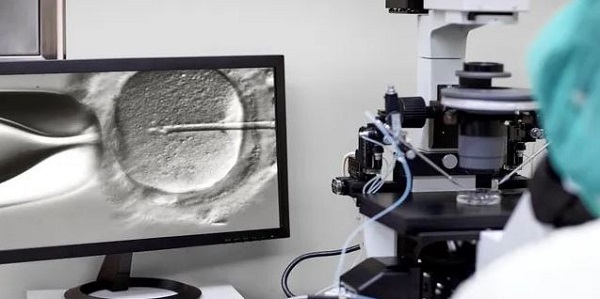AIVF, an Israeli reproductive technology company, has successfully developed AI-powered embryo quality assessment software that simplifies the embryo selection process in In Vitro Fertilisation (IVF).
Artificial intelligence (AI) has been shown to detect cancer, identify cavities, and answer medical questions.
Now, AI also acts as an “effective assistant” to help reproductive doctors select the best embryos for in vitro fertilization (IVF).
According to information from the Centers for Disease Control and Prevention (CDC), 1 in 5 adult women cannot get pregnant naturally after one year of trying.
Therefore, many people decide to look to IVF – the method that has helped many women in the US get pregnant. However, the effectiveness of this method cannot be guaranteed.
According to the American Society of Reproductive Medicine, the cost of one time IVF is very expensive, averaging about $12,000 per cycle. In fact, most IVF procedures involve more than one treatment cycle.
Artificial intelligence can help doctors in embryo selection
AI software supports embryo selection
To improve IVF operations, AIVF, a reproductive technology company in Tel Aviv, Israel, has successfully developed AI-powered embryo quality assessment software, with the aim of reducing the number of insemination cases. test tube failed.
Software called EMA is programmed to process huge amounts of data beyond human capabilities, simplifying the embryo selection process.
In the words of Daniella Gilboa, an embryologist, co-founder, and CEO of AIVF, who shared with Fox News Digital: “IVF stands as one of the most significant advancements in the field of medicine, during the past 50 years. But this method is still not good enough. The success rate (of IVF) is only between 23-25% in all age groups. This also means that only one in five people who do IVF will be able to conceive successfully.”
According to Gilboa, one of the biggest challenges today is that IVF clinics cannot keep up with the increased demand.
“More and more women are choosing to freeze their eggs to delay childbirth and focus on pursuing a career,” she said. That means the need for IVF is increasing while resources are limited.”
For example, in the US, only 20% of the need for IVF is met, which means that the remaining 80% of women have to give up their dream of becoming a mother.
According to Gilboa, embryo selection is one of the most important steps in the IVF process. Usually, the choice of embryo will be decided by a doctor with good expertise.
“Imagine you are an embryologist, looking at a bunch of different embryos in a busy lab environment and having to decide which embryo is most likely to help conception. You may have to weigh 10 or 12 embryos with identical shapes and sometimes have to make difficult choices yourself,” Gilboa said.
However, with the help of EMA software, the embryo quality assessment process becomes significantly easier, thanks to the application of advanced algorithms to select embryos with a high probability of successful conception. best.
According to Gilboa, the AI tool has been “trained” to detect embryonic traits that determine different outcomes (gender, implantation, or genetic abnormalities, etc.) that the human eye can’t. can be seen.
The final selection will be made based on the evaluation score of each embryo.
Gilboa also said that without AI, doctors would have to judge the quality of embryos based on their appearance.
“However, this approach is purely based on subjective human analysis without really quantifying the actual success rate of conception. Meanwhile, AI possesses the ability to help doctors eliminate possible uncertainties, and provide clear and accurate information,” she said.
Compared to humans, this AI tool is capable of making an assessment of embryo quality in a much shorter period of time. This also means that clinics can serve more patients and meet more needs.
EMAs are “trained” through time-lapse videos of embryonic development. The software must analyze which embryos have a positive outcome and which are less likely to conceive.
“You need (process) a huge amount of data. This is a lengthy, multi-stage process to build a model that’s good enough to be applicable (in medicine),” Gilboa said.
AI software will help increase the chances of successful conception.
Appreciated by leading experts
Dr. Shahin Ghadir, a fertility researcher and a fertility doctor in California, says that artificial intelligence-powered products like the EMA will help. very useful.
Speaking to Fox News Digital, Ghadir said: “The development of reproductive medicine is facing major obstacles, due to the shortage of human resources and lack of expertise in this field. Also because the number of embryologists is very limited and often difficult to train, new technology will be very welcome.”
While EMA can help optimize and speed up the embryo selection process, Gilboa notes that the software is not intended to replace the role of doctors.
Ultimately, EMA and similar software are just tools to assist doctors in the embryo assessment process, advise patients and provide IVF services more effectively.
According to Gilboa, this is not (a war) where humans confront AI but where humans “alligate” with AI for a good cause.
While Ghadir himself supports the idea of using AI in the medical field, he also emphasizes the need to “carefully consider important criteria” before making a final decision.
It is not excluded that some risks, such as errors in embryo classification, will affect the final outcome of the IVF operation.
In addition, ethical factors also need to be considered when using AI for embryo selection. This can affect the decision of the individual and the patient’s family.
EMA software is currently being used in European countries, Southeast Asia, South America and is expected to be available in the US in the near future.
According to Gilboa, most of the clinics that have purchased and experienced it have given very positive feedback on the quality of this software.
The technology also provides cost savings for patients as the time required for successful conception is significantly shortened.
According to Gilboa, with traditional IVF, to get pregnant successfully, patients have to go through an average of 3-5 cycles of treatment. But with the EMA, this is reduced to just a 1.6 period average.
And so, thanks to the application of AI technology, the dream of being a parent of infertile patients can completely be realized through IVF method.












